2008 USA trip (part 1)
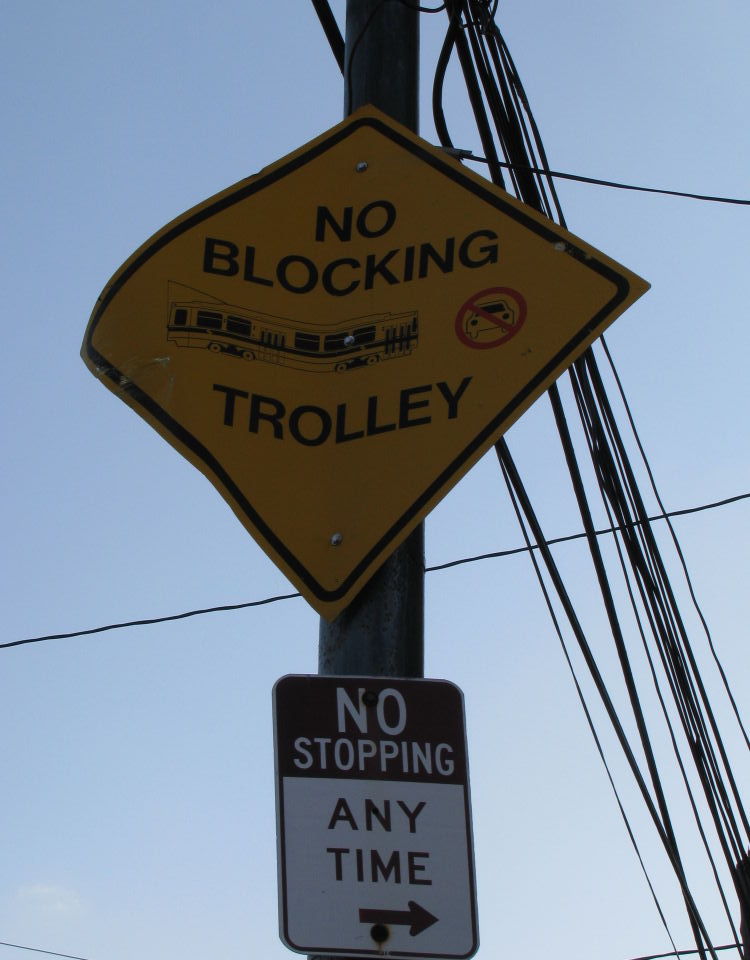 The USA had long been a place that I would at some point have liked to visit, but it had never become anything like a priority and I wasn't expecting to set foot there anytime soon. However, when the prospect of a business trip arose, this didn't take long to germinate into a bigger project. The business call involved a trade fair in Houston followed by a visit to a research center in Raleigh, accounting for about a week in total. Despite the non-negligible workload back in the office, I decided I could get away with adding a week for private sightseeing. Now to decide on what to do.
The USA had long been a place that I would at some point have liked to visit, but it had never become anything like a priority and I wasn't expecting to set foot there anytime soon. However, when the prospect of a business trip arose, this didn't take long to germinate into a bigger project. The business call involved a trade fair in Houston followed by a visit to a research center in Raleigh, accounting for about a week in total. Despite the non-negligible workload back in the office, I decided I could get away with adding a week for private sightseeing. Now to decide on what to do.
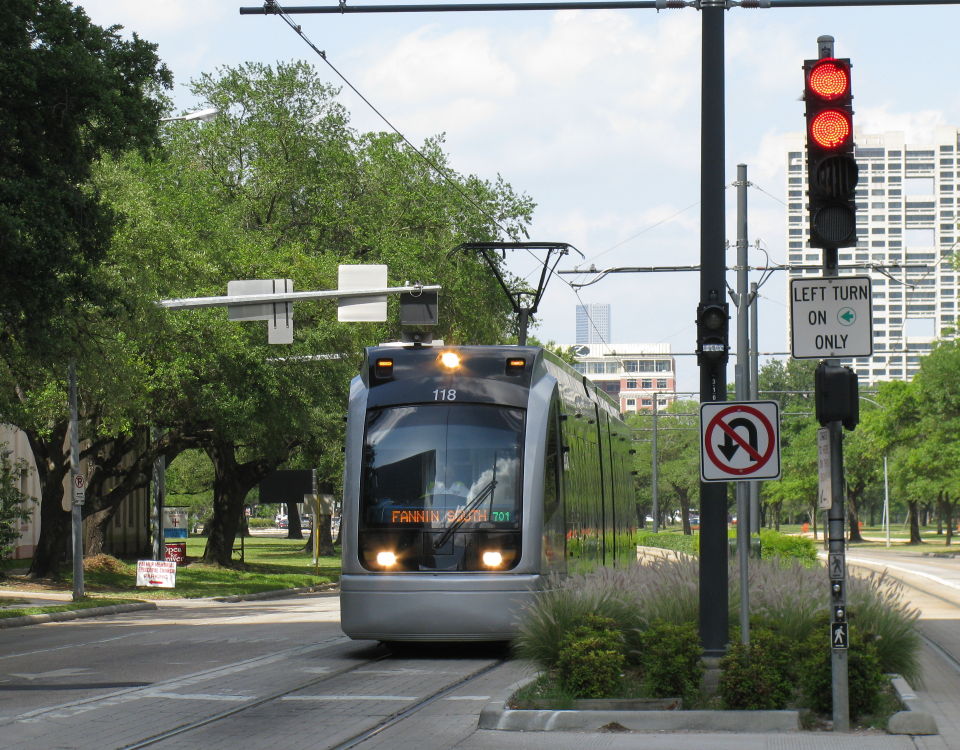 I knew I definitely wanted to do at least part of my travels by train. I also knew I wanted to use the opportunity to visit a friend in Dallas. I additionally wanted to see some trams (or trolleys as the Americans call them). Making all this fit into a coherent trip with what in hindsight turned out to be a limited knowledge of US geography, led to much time spent on Google and on the Amtrak journey planner website. There is a historic trolley in Charlotte, a city that is in the same state as Raleigh, but the website showed the service is currently suspended. Furthermore, the desire to see genuine old trolleys rather than some museum-like tourist attraction convinced me that it was Phladelphia I should be heading for. When I discovered there was a direct Amtrak train from Raleigh, I needed no further convincing.
I knew I definitely wanted to do at least part of my travels by train. I also knew I wanted to use the opportunity to visit a friend in Dallas. I additionally wanted to see some trams (or trolleys as the Americans call them). Making all this fit into a coherent trip with what in hindsight turned out to be a limited knowledge of US geography, led to much time spent on Google and on the Amtrak journey planner website. There is a historic trolley in Charlotte, a city that is in the same state as Raleigh, but the website showed the service is currently suspended. Furthermore, the desire to see genuine old trolleys rather than some museum-like tourist attraction convinced me that it was Phladelphia I should be heading for. When I discovered there was a direct Amtrak train from Raleigh, I needed no further convincing.
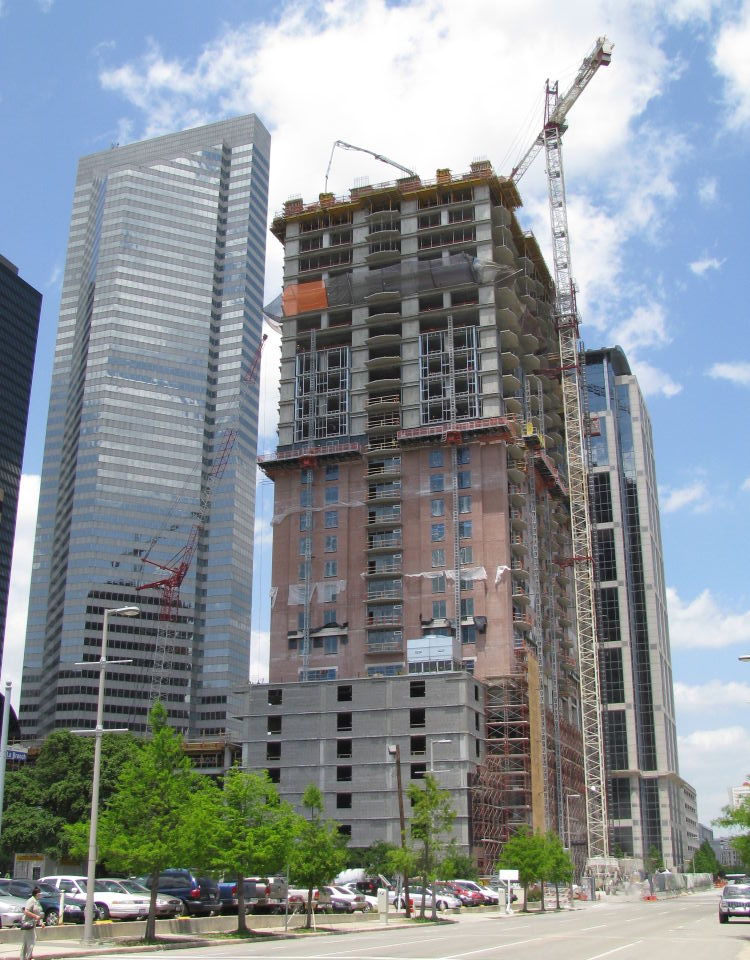 Furthermore, another friend expressed interest in joining me for at least the latter part of my trip, and his only reasonable flights went into Chicago. This meant that I would catch a train from Philadelphia to Chicago to meet him, and that we would together go down to Dallas – agan by train.
Furthermore, another friend expressed interest in joining me for at least the latter part of my trip, and his only reasonable flights went into Chicago. This meant that I would catch a train from Philadelphia to Chicago to meet him, and that we would together go down to Dallas – agan by train.
The initial euphoria faded somewhat when the geographic realities fell into place. I began to wonder whether I hadn't taken a foolish decision and crammed far too much into too short a time. Was I not doing in America exactly what the Americans of jokes (and sadly of reality sometimes) do in Europe, ie, try to see London, Heidelberg and Venice on the same afternoon and go home believing that Salzburg is the most beautiful city in Paris.
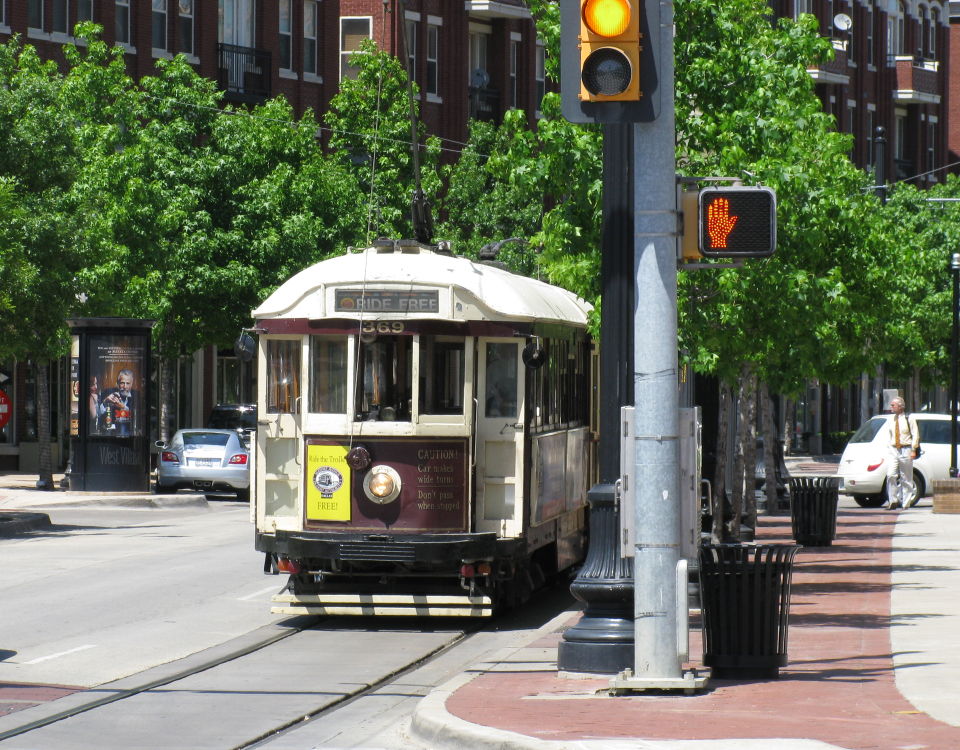 My doubts took a further nosedive when the complex mechanics of the detailed planning of the official part of the trip squealed into motion.
My doubts took a further nosedive when the complex mechanics of the detailed planning of the official part of the trip squealed into motion.
But first I must explain why my case was getting so difficult. The weekend before my departure I was to spend in Jena (Germany) visiting a conference (privately). This combined with the prospect of an early departure on the Monday morning (and a flight that passed through Frankfurt anyway) led me to innocently enquire whether I couldn't catch the flight in Frankfurt directly, or maybe even get a connecting flight from Erfurt or somewhere else in the area, rather than catching the night train to Zürich and then flying back. Of course I would have payed any additional costs that this might imply myself.
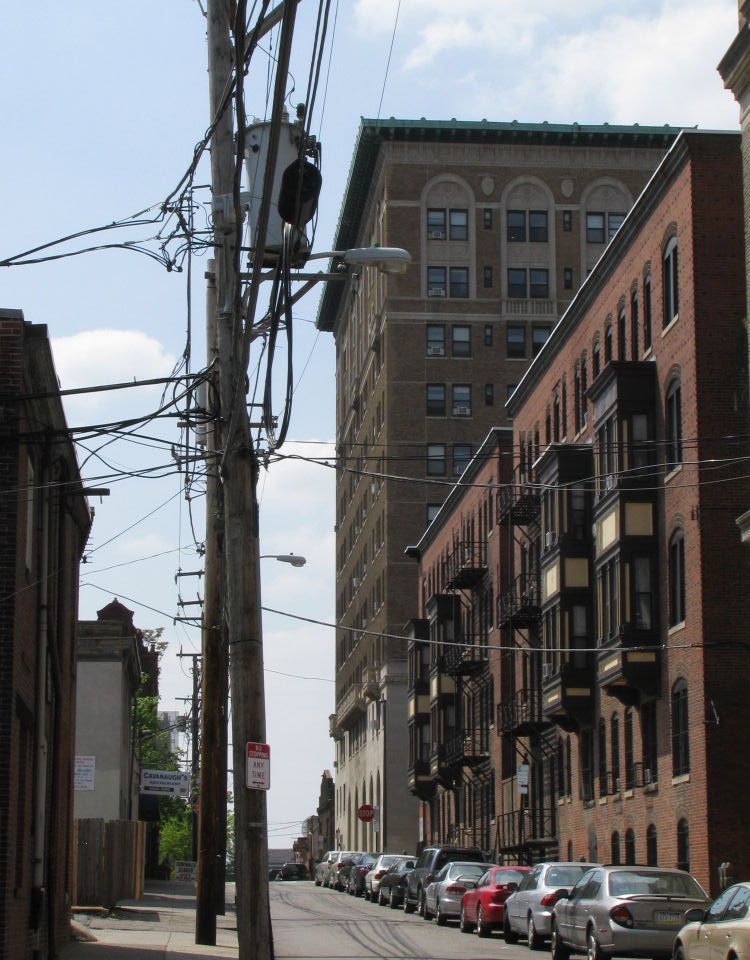 This is exactly the sort of question one shouldn't ask of a large travel agency working for a corporate customer – unless one is prepared to insist and be very difficult and get one's name blacklisted through several levels of hierarchy. Unfortunately, when it finally dawned on me that this is exactly what I should have done it was too late. I shouldn't complain too bitterly as the folks at Kuoni had at least taken into account part of my wishes: they routed me via Frankfurt. But they couldn't actually let me start my journey there as this had to start in Zürich.
This is exactly the sort of question one shouldn't ask of a large travel agency working for a corporate customer – unless one is prepared to insist and be very difficult and get one's name blacklisted through several levels of hierarchy. Unfortunately, when it finally dawned on me that this is exactly what I should have done it was too late. I shouldn't complain too bitterly as the folks at Kuoni had at least taken into account part of my wishes: they routed me via Frankfurt. But they couldn't actually let me start my journey there as this had to start in Zürich.
Fortunately, the private parts of the trip proved easier to book. The Amtrak website permits the booking of trains in a very simple and user-friendly manner.
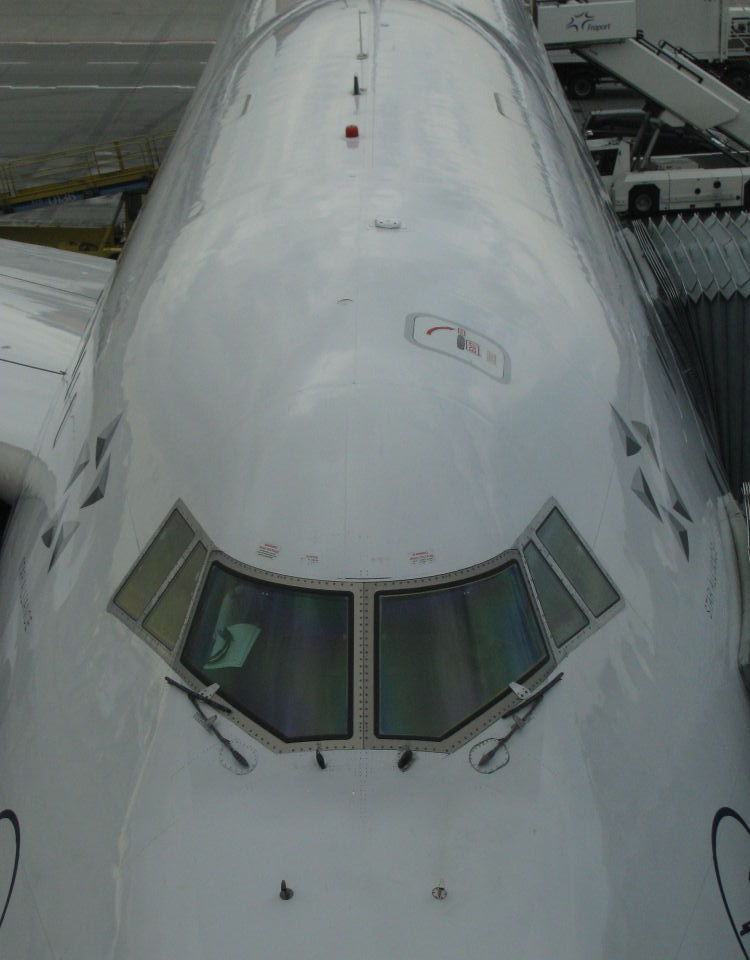 And so it was very early on the morning of Tuesday 29th April I made my way to Zürich airport. From there to Frankfurt and then the long haul to Houston.
And so it was very early on the morning of Tuesday 29th April I made my way to Zürich airport. From there to Frankfurt and then the long haul to Houston.
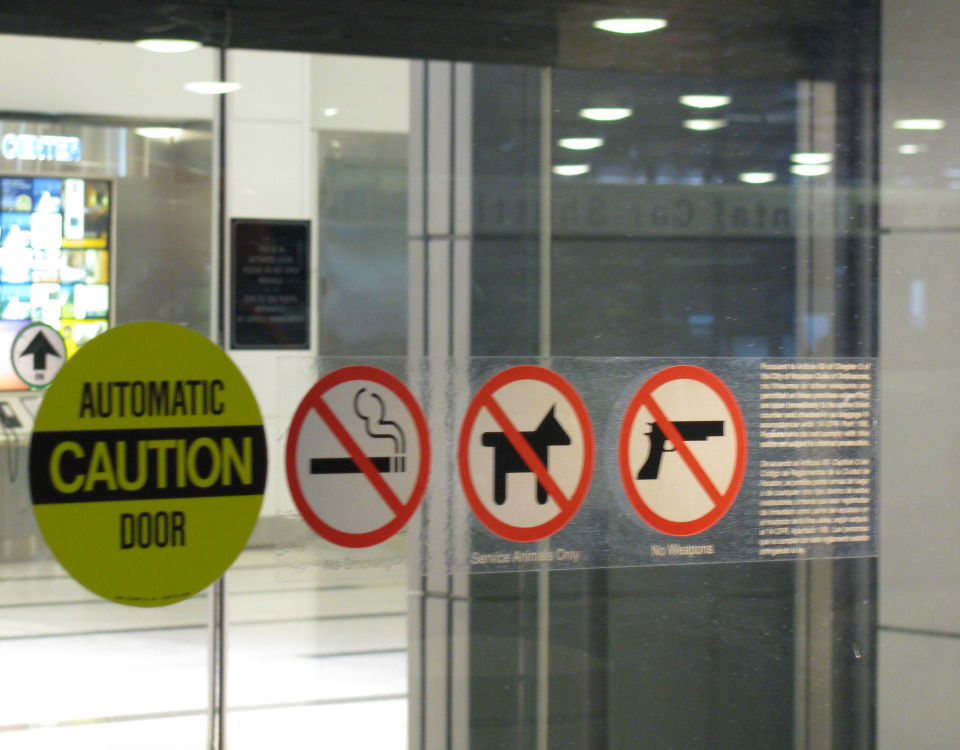 I had smiled somewhat at the check-in in Zürich to see a sign saying that it was punishable to use foul language to the checkin staff, and wondered whether maybe this sign wouldn't be necessary if the staff would be slightly more helpful. However in Houston I saw this sign at the entrance to the airport. Don't shoot the check-in staff!
I had smiled somewhat at the check-in in Zürich to see a sign saying that it was punishable to use foul language to the checkin staff, and wondered whether maybe this sign wouldn't be necessary if the staff would be slightly more helpful. However in Houston I saw this sign at the entrance to the airport. Don't shoot the check-in staff!
Houston's airport is called George Bush. There is a highway called George Bush and there is even a George Bush monument. The Bush family, of course, is linked to Houston, and Houston is built on oil.
You can apparently get from the airport to downtown Houston by bus. I had checked the schedules but not considered it necessary to print these out. Consequently I didn't know the departure point for the bus and was able to discover neither signs for this nor any knowledgeable staff. The whole setup, I suppose, must be designed to channel as many customers onto the taxis as possible.
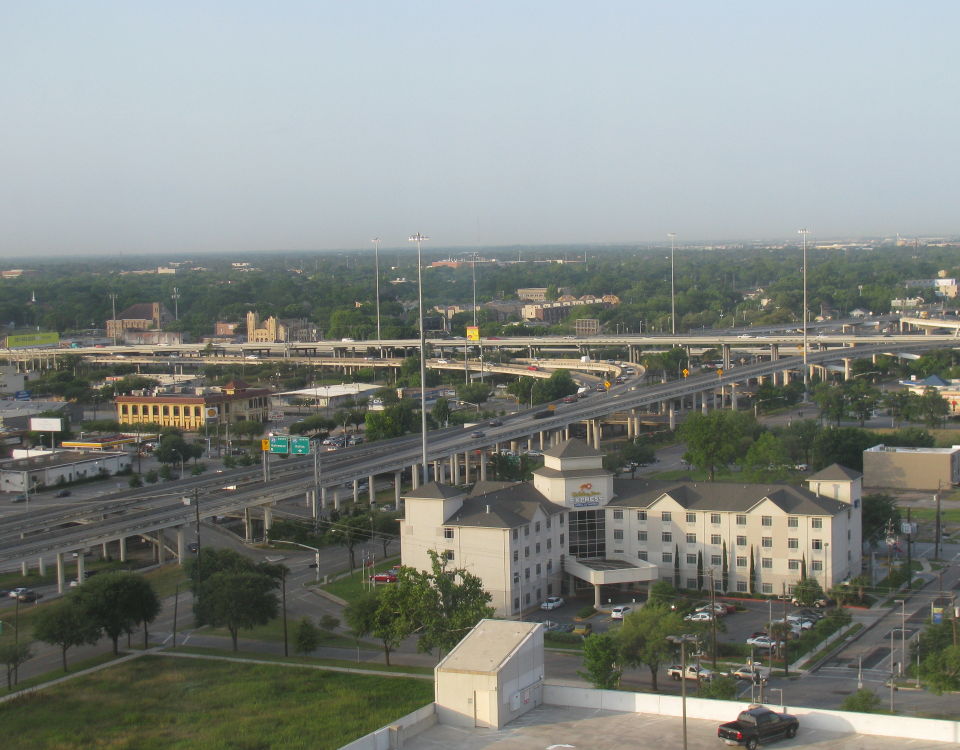 Riding the taxi into Houston is itself an impressive experience. The roads are extremely wide with large numbers of lanes, with the traffic being extremely peaceful by European standards. There is no breakneck overtaking or other immature intimidation of other road users. Cars respect the proper distance to the vehicle in front and traffic flows are continuously orderly and disciplined. I was later to make similar observations while walking the streets to photograph trams. Nobody walks outside teh central area, but you can walk everywhere, there are decent footpaths and zebra and pelican crossings, which motorists invariably respect. If you have to jay-walk to reacgh some traffic island or other photographic vantage point, nobody gets annoyed about that either. In Europe, every motorist considers himself a self-appointed police officer whose job it is to point out the faults of others. In the USA, people don't interfere unless they genuinely want to help.
Riding the taxi into Houston is itself an impressive experience. The roads are extremely wide with large numbers of lanes, with the traffic being extremely peaceful by European standards. There is no breakneck overtaking or other immature intimidation of other road users. Cars respect the proper distance to the vehicle in front and traffic flows are continuously orderly and disciplined. I was later to make similar observations while walking the streets to photograph trams. Nobody walks outside teh central area, but you can walk everywhere, there are decent footpaths and zebra and pelican crossings, which motorists invariably respect. If you have to jay-walk to reacgh some traffic island or other photographic vantage point, nobody gets annoyed about that either. In Europe, every motorist considers himself a self-appointed police officer whose job it is to point out the faults of others. In the USA, people don't interfere unless they genuinely want to help.
Soon the high rise central area of Houston shows up on the horizon. Being used to the European style of town, where buildings gradually get larger as the centre draws nearer, Houston's high-rise area of Houston is concentrated in a very small area with very abrupt limits, making it look as if a patch of high-rise had been cut out of a larger city and grafted into an otherwise low-density flat area.
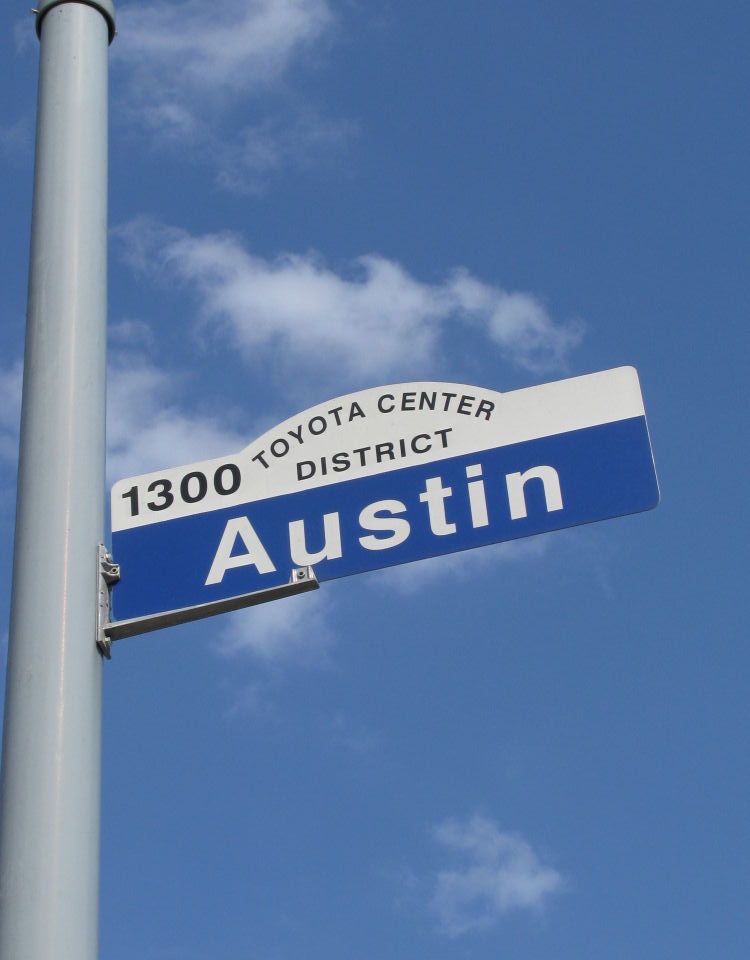 Once inside the downtown high-rise area, it becomes apparent that the city isn't as densely built as it looks. There are numerous empty plots of land between the large buildings, almost as if the graft hadn't really taken root and wasn't yet growing. Many of these spare plots are used for car-parking, but look as if he are intended for development at some future point, making the entire town look somewhat unfinished. The whole impression is somewhat surreal. Being in Houston is not like being in a city at all. Despite probably having millions of inhabitants in its catchment area, Houston feels like a small town that somehow go some big buildings. This impression was to be confirmed later as I made my way around. There is little evidence of that big city attitude, but more a rustical and slow pace of life somehow captured in a city setting.
Once inside the downtown high-rise area, it becomes apparent that the city isn't as densely built as it looks. There are numerous empty plots of land between the large buildings, almost as if the graft hadn't really taken root and wasn't yet growing. Many of these spare plots are used for car-parking, but look as if he are intended for development at some future point, making the entire town look somewhat unfinished. The whole impression is somewhat surreal. Being in Houston is not like being in a city at all. Despite probably having millions of inhabitants in its catchment area, Houston feels like a small town that somehow go some big buildings. This impression was to be confirmed later as I made my way around. There is little evidence of that big city attitude, but more a rustical and slow pace of life somehow captured in a city setting.
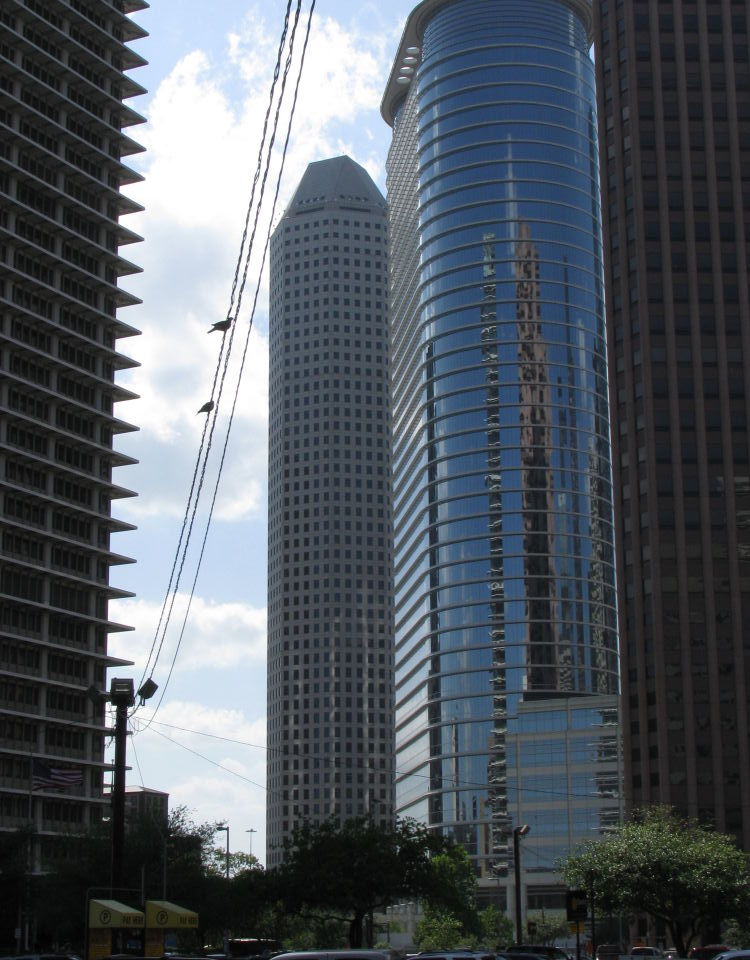 Having lost much more time queuing for US immigration than I had possibly thought possible, I had missed most of the day's events, but was still able to take a look around the exhibition area and to meet up with a number of people.
Having lost much more time queuing for US immigration than I had possibly thought possible, I had missed most of the day's events, but was still able to take a look around the exhibition area and to meet up with a number of people.
Rather than going into the details of the fair and my activities there – and because they, like most others, don't like people to blog about them – I'll skip those bits, only saying that I was given a great award which made me feel very good.
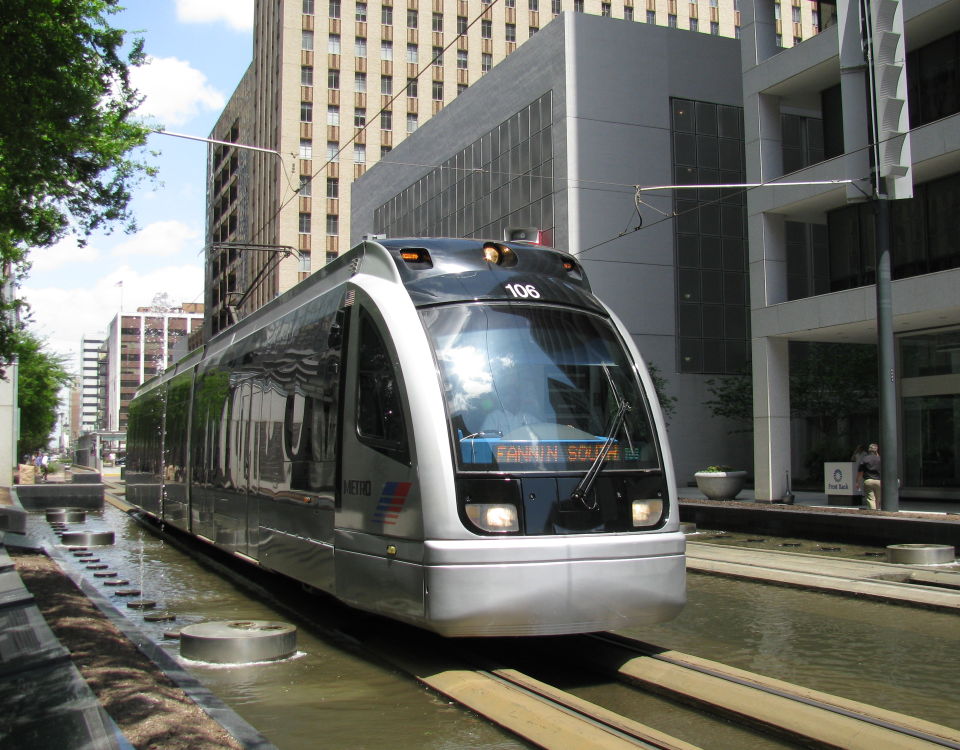 But I suppose you'll want to know whether I got to ride Houston's light-rail line. Fortunately I did manage to find time for that. Houston has a single line which cuts through the downtown area and extends some way into the suburbs at one end. The alignment is built to a high standard, with the central section being in a pedestrianised street. Besides the tram, this has been embellished with neat paving, greenery and a fountain through which the tram runs.
But I suppose you'll want to know whether I got to ride Houston's light-rail line. Fortunately I did manage to find time for that. Houston has a single line which cuts through the downtown area and extends some way into the suburbs at one end. The alignment is built to a high standard, with the central section being in a pedestrianised street. Besides the tram, this has been embellished with neat paving, greenery and a fountain through which the tram runs.
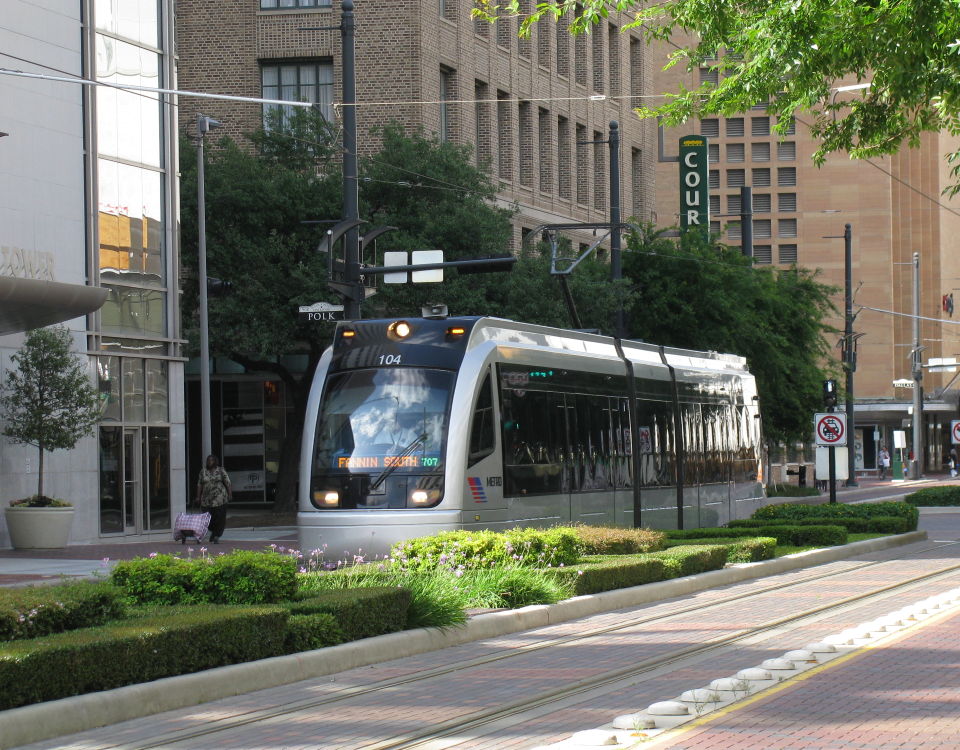 The vehicles themselves actually look better in reality than they do on photos. The interior is kept simple through extensive use of vandal-proof stainless-steel components (as I was also to discover in the other cities in which I was to ride). There were no signs of vandalism so this strategy is either working, or graffiti isn't such a problem any more. It does however lead to these vehicles being somewhat dull on the inside.
The vehicles themselves actually look better in reality than they do on photos. The interior is kept simple through extensive use of vandal-proof stainless-steel components (as I was also to discover in the other cities in which I was to ride). There were no signs of vandalism so this strategy is either working, or graffiti isn't such a problem any more. It does however lead to these vehicles being somewhat dull on the inside.
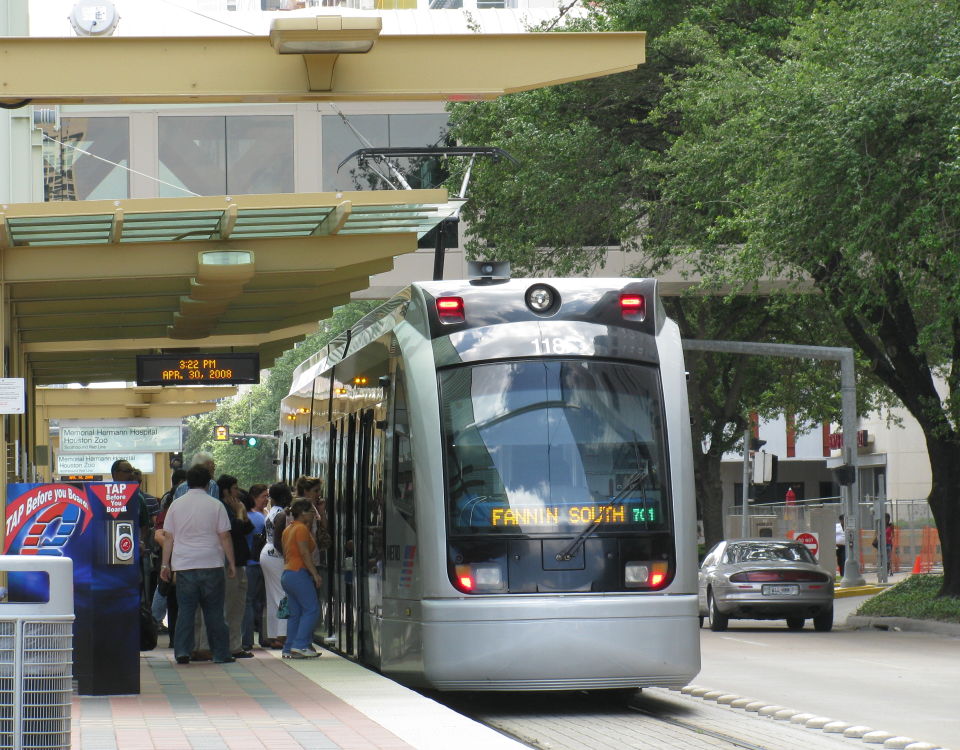 These trams (again in common with those that I was to see elsewhere) presented a high proportion of seated accomodation. Although many passengers (including myself) did stand for much of the journey, it would seem that management are not just interested in carrying as many passengers as possible, but in offering a service that is attractive as possible. Also of interest was that on the three journeys I made, a wheelchair user was on two of them. On European trams, low-floor trams do visibly make life easier for parents with prams, but wheelchair users remain something of a rarity.
These trams (again in common with those that I was to see elsewhere) presented a high proportion of seated accomodation. Although many passengers (including myself) did stand for much of the journey, it would seem that management are not just interested in carrying as many passengers as possible, but in offering a service that is attractive as possible. Also of interest was that on the three journeys I made, a wheelchair user was on two of them. On European trams, low-floor trams do visibly make life easier for parents with prams, but wheelchair users remain something of a rarity.
I travelled to the Fannin South terminus, a park-and-ride site on a scale that is only rarely seen in Europe. Towards the terminus, the distance between stops grows longer and longer and cruising speeds increase.
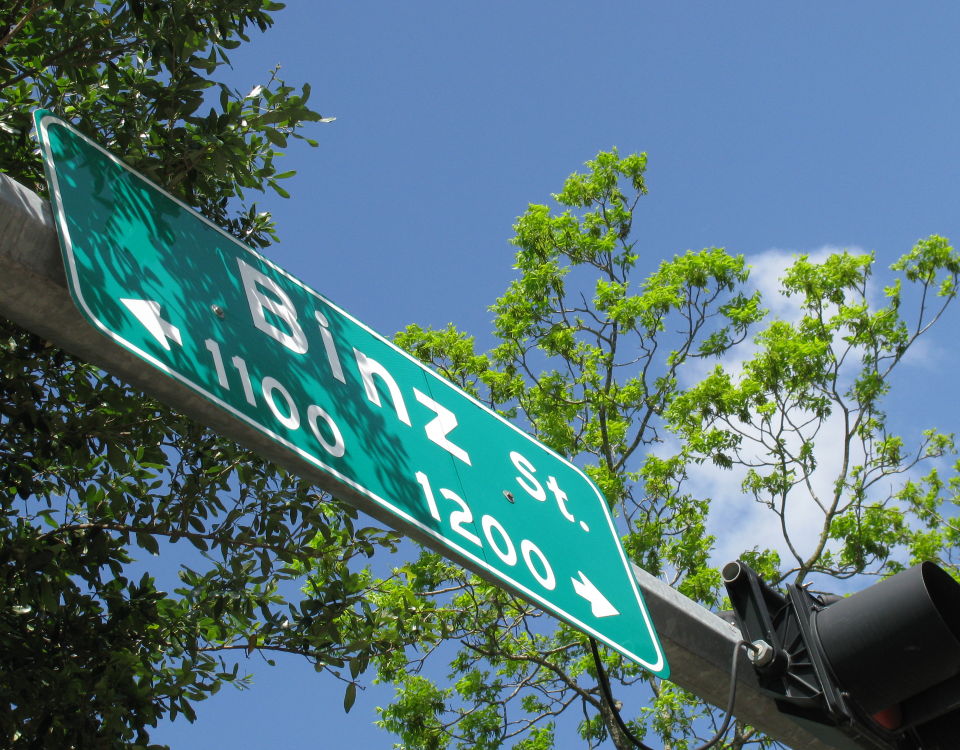 I was please to discover that Houston and Zürich have something in common – a Binz Str!
I was please to discover that Houston and Zürich have something in common – a Binz Str!
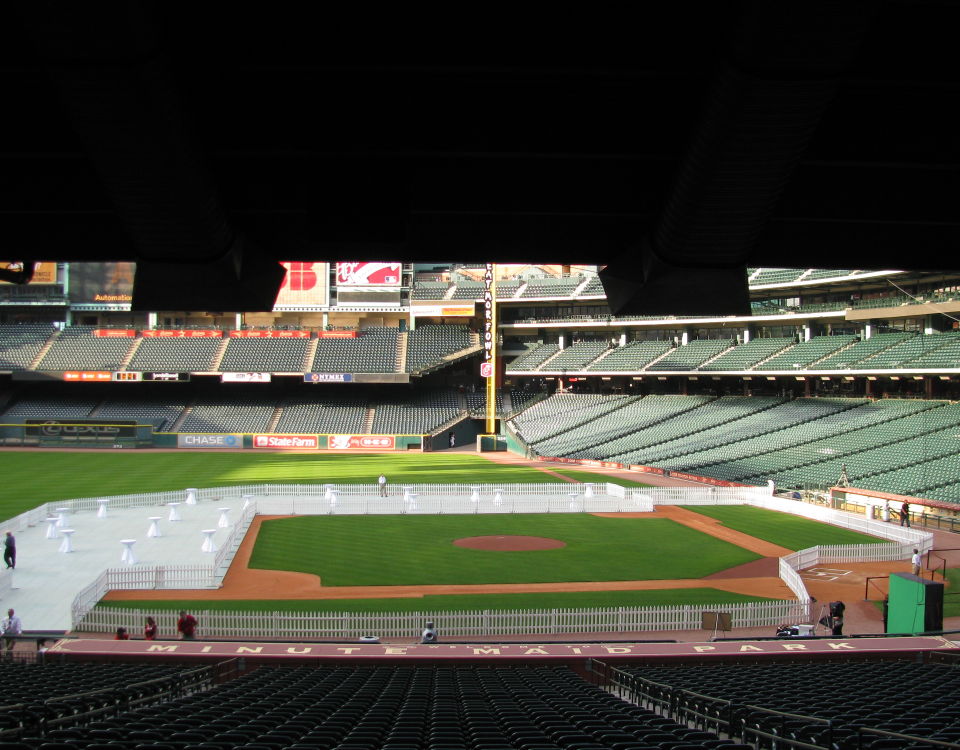 The rest of my Houston-stay was largely concerned with business matters. The company did, however, lay on an event in the nearby Minute Maid Stadium home of the Astros baseball team. The first thing I learnt, was that Minute Maid, the drinks company with whose products I was already famliar, is named after the measure of time rather than the diminished stature of the lady in question.
The rest of my Houston-stay was largely concerned with business matters. The company did, however, lay on an event in the nearby Minute Maid Stadium home of the Astros baseball team. The first thing I learnt, was that Minute Maid, the drinks company with whose products I was already famliar, is named after the measure of time rather than the diminished stature of the lady in question.
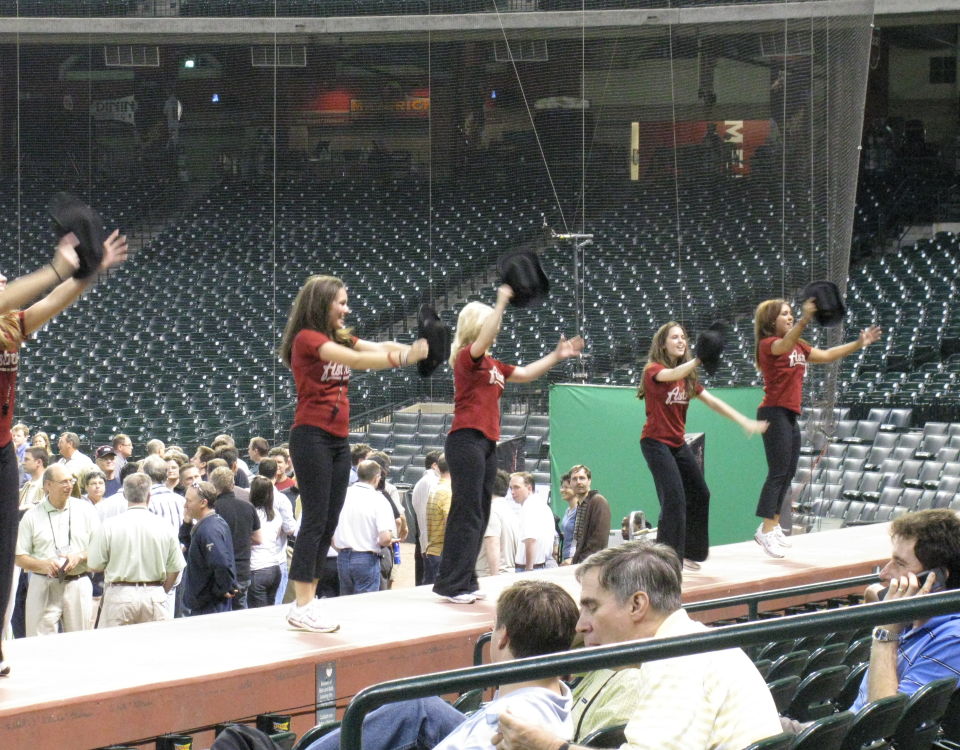 The event was laid on in grand style, with free food and drinks, games and Karaoke. Guided tours were provided, including the opportunity to go down onto the grass &ndash: a real and rare honour for a country where Baseball is of such importance!
The event was laid on in grand style, with free food and drinks, games and Karaoke. Guided tours were provided, including the opportunity to go down onto the grass &ndash: a real and rare honour for a country where Baseball is of such importance!
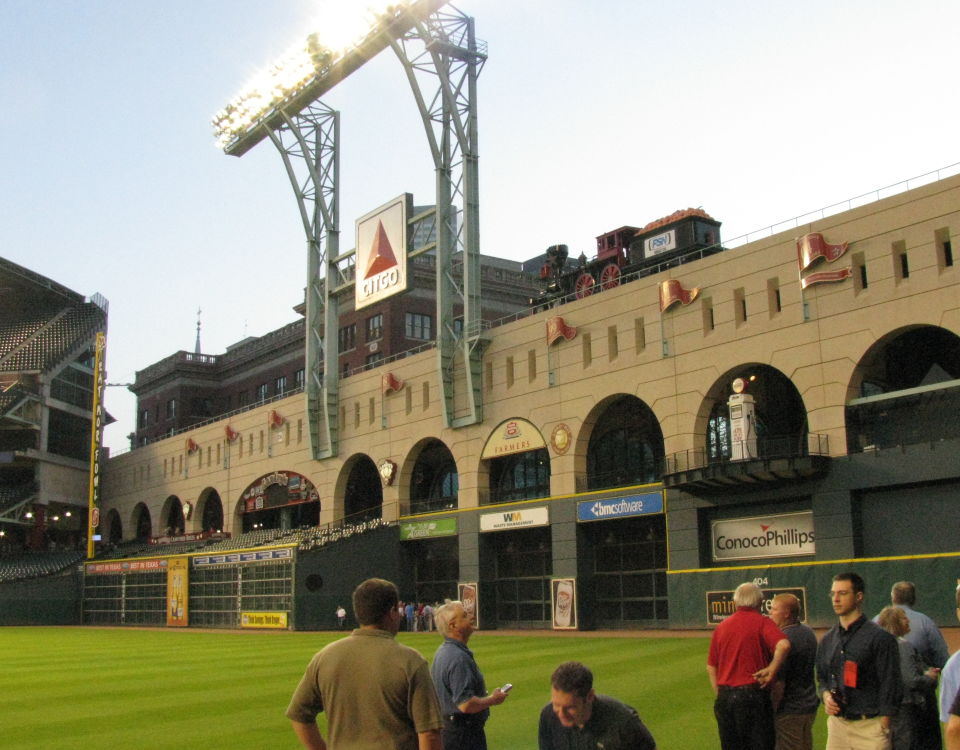 I learnt that the stadium was built on the site of the former Union Station, hence the large Southern Pacific steam locomotive outside, and a smaller locomotive (probably a replica?) running to and fro on the stadium wall – its tender loaded with oranges, reflecting the product of Minute Maid.
I learnt that the stadium was built on the site of the former Union Station, hence the large Southern Pacific steam locomotive outside, and a smaller locomotive (probably a replica?) running to and fro on the stadium wall – its tender loaded with oranges, reflecting the product of Minute Maid.
The official part of my trip ended in Raleigh NC on 2nd May. Raleigh is a totally different place than Houston. There isn't as much money around, but it is clearly more steeped in traditions and history. On the whole it is a very pleasant and civilized place to be and one I could easily imagine spending more time.
At this point I should dispel a myth about America. My experience in Raleigh (and also other places) showed that there are good restauants in the USAserving excellent food at a very moderate price. If many Americans are runing their health with junk food, that is a matter of choice and not for lack of alternatives, as is often siggested.
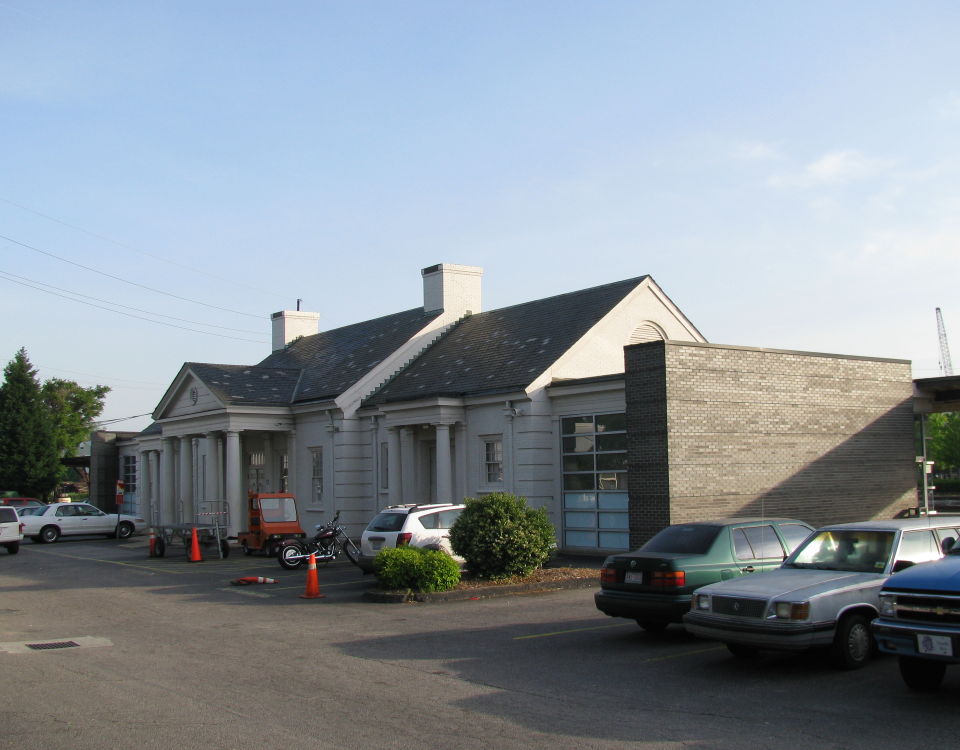 Early the next morning I was at Raleigh station. For such a large town, it is a very small station indeed. I picked up the tickets I had booked on he internet. The other passengers were all sorts of people, not too different from those you would expect in Europe, ranging from students and families to pensioners. The boarding procedure was something new to me however. I was surprised that despite having a reservation, my ticket didn't actually indicate the number of the coach or seat in which I could expect to find this seat. The reason became clear when the train arrived. The conductor walked along the platform and asked everybody where they were going and allocated seats accordingly.
Early the next morning I was at Raleigh station. For such a large town, it is a very small station indeed. I picked up the tickets I had booked on he internet. The other passengers were all sorts of people, not too different from those you would expect in Europe, ranging from students and families to pensioners. The boarding procedure was something new to me however. I was surprised that despite having a reservation, my ticket didn't actually indicate the number of the coach or seat in which I could expect to find this seat. The reason became clear when the train arrived. The conductor walked along the platform and asked everybody where they were going and allocated seats accordingly.  The Amtrak train itself was comfortable (albeit a little old-fashioned) and the staff attentive.The area we crossed was largely flat or with smaller hills, with many smaller farmhouses and woodland. The colours of the trees is very intense – much more so than in Europe. It also struck me (here and elsewhere) that the types of trees are totally different from those in Europe. Occasionally I though I recognised something I knew, but it turned out to be something different. The birds too, look different and sing differently. No wonder this was a "new world" for the early settlers.
The Amtrak train itself was comfortable (albeit a little old-fashioned) and the staff attentive.The area we crossed was largely flat or with smaller hills, with many smaller farmhouses and woodland. The colours of the trees is very intense – much more so than in Europe. It also struck me (here and elsewhere) that the types of trees are totally different from those in Europe. Occasionally I though I recognised something I knew, but it turned out to be something different. The birds too, look different and sing differently. No wonder this was a "new world" for the early settlers.
At Washington, traction changes over from diesel to electric. The cities grow larger the further North we get. Finally we arrive in Philadelphia's 30th Street Station.
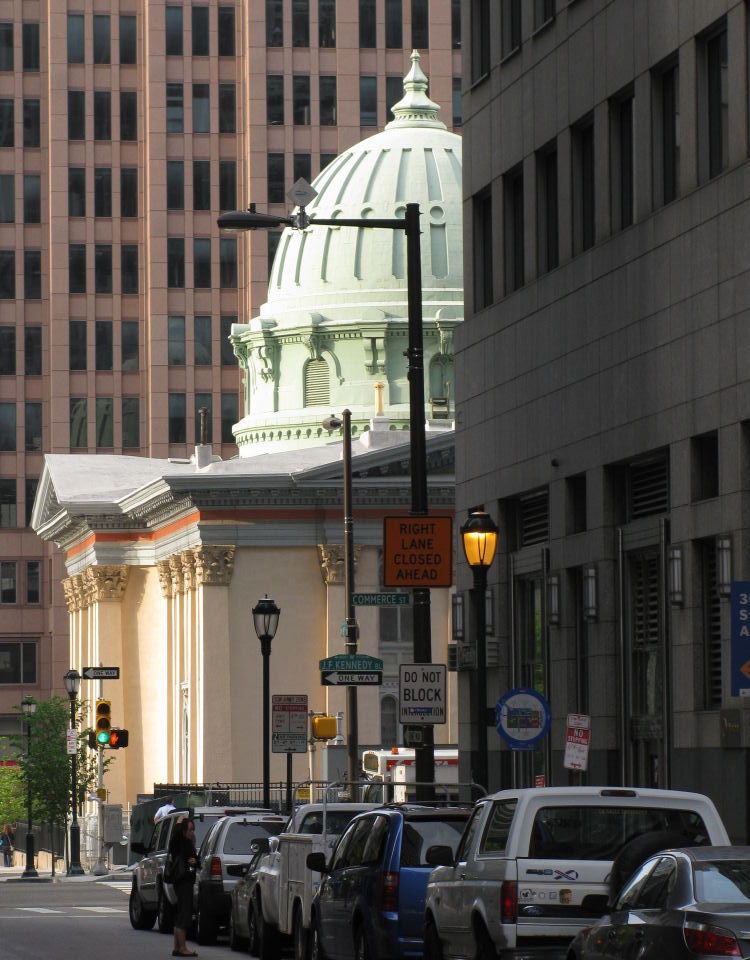 Philadephia was the first place in the USA that really made me feel like being in a large city. The centre has many large skyscrapers, which in reality look much more attractive and welcoming than the do on photographs.
Philadephia was the first place in the USA that really made me feel like being in a large city. The centre has many large skyscrapers, which in reality look much more attractive and welcoming than the do on photographs.
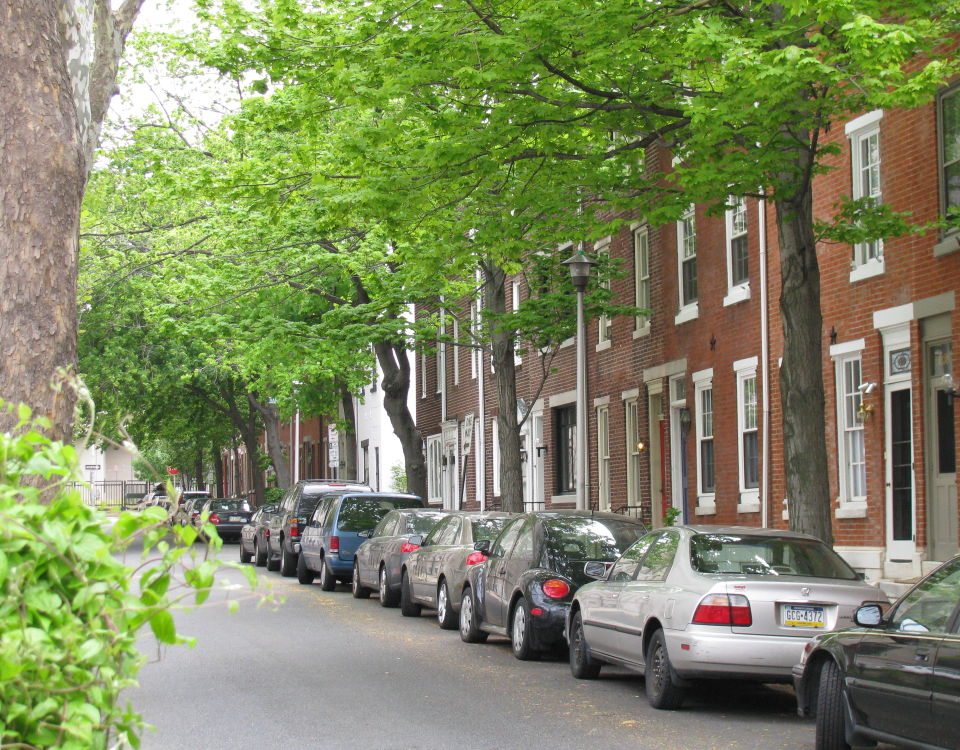 Interspersed among these are older buildings, many of them very elaborate and impressive. Some areas also have Georgian-style terraced houses, giving the town an old English feel.
Interspersed among these are older buildings, many of them very elaborate and impressive. Some areas also have Georgian-style terraced houses, giving the town an old English feel.
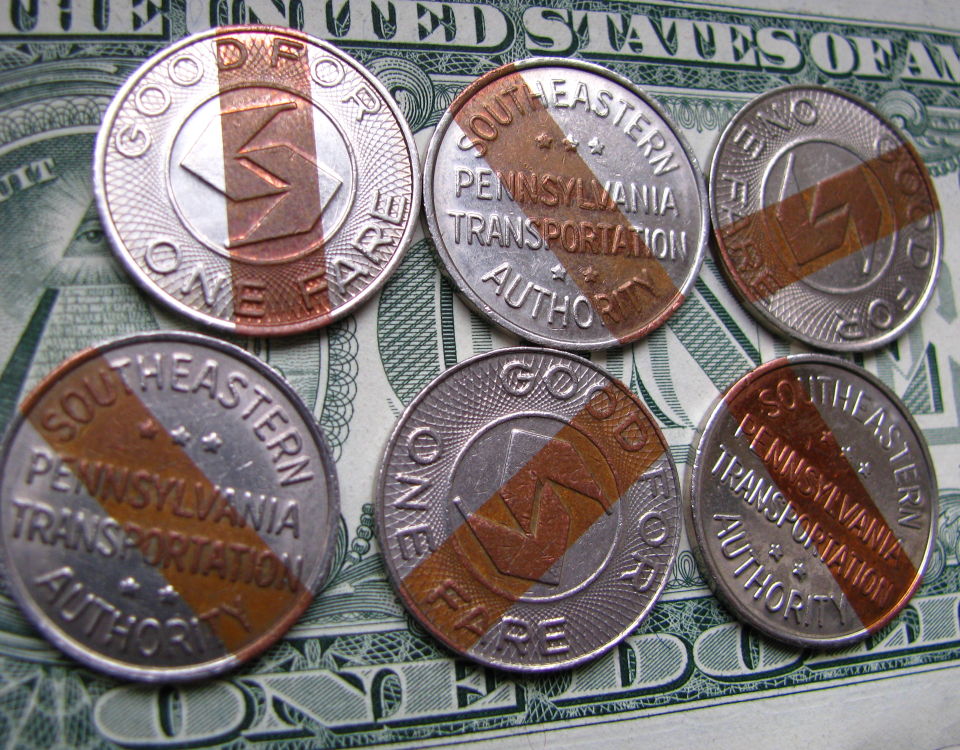 Although public transport can be paid in cash, the best way to travel is to use tokens. The more of these you buy, the cheaper they get. These tokens are a kind of coin that can be inserted into the turnstiles to enter underground stops and stations, but can also be dropped into a driver-supervised farebox on buses and trams at surface stations. No receipt is issued making further inspections impossible. Changing modes consequently calls for a renewal of payment (except in the subterranean exchanges).
Although public transport can be paid in cash, the best way to travel is to use tokens. The more of these you buy, the cheaper they get. These tokens are a kind of coin that can be inserted into the turnstiles to enter underground stops and stations, but can also be dropped into a driver-supervised farebox on buses and trams at surface stations. No receipt is issued making further inspections impossible. Changing modes consequently calls for a renewal of payment (except in the subterranean exchanges).
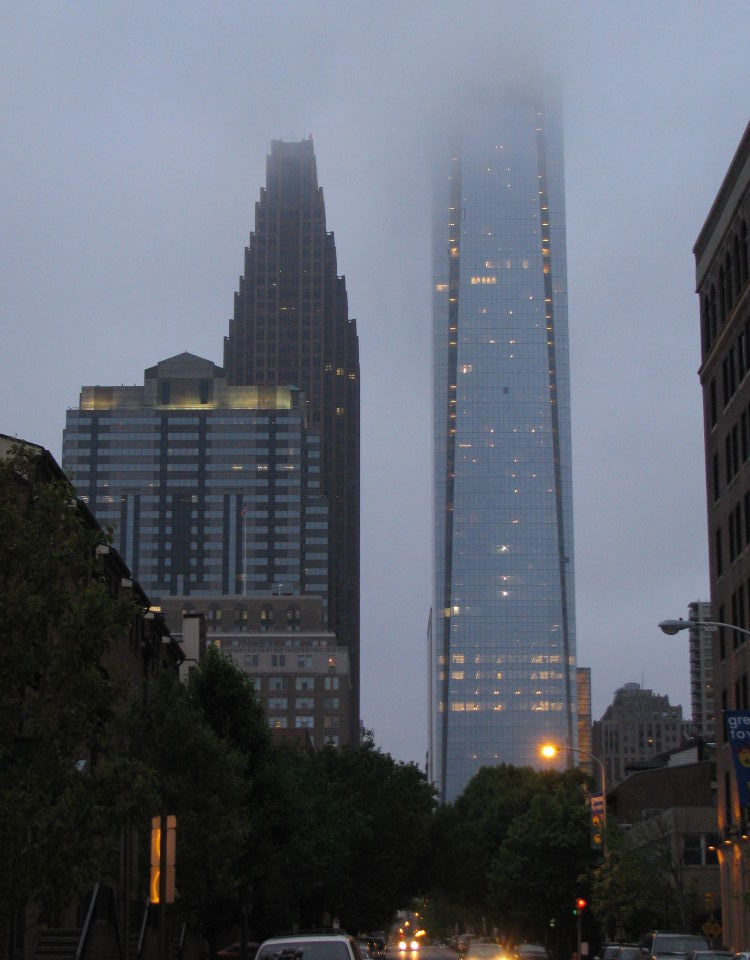 Despite many route closures, Philadelphia still has an extensive tram system. The only part of this that runs in the central area, however, is the Market Street subway. This subway is an impressive four-track affair. The outer lines are used by trolleys on local services, with the inner tracks being used by metro trains (the Market-Frankford line). I believe this was originally also a trolley service. The present metros have very narrow bodies, hailing to this situation. The four-track alignment ends at 13th street, with the trolleys turning in an underground loop passing below the level of the fast lines.
Despite many route closures, Philadelphia still has an extensive tram system. The only part of this that runs in the central area, however, is the Market Street subway. This subway is an impressive four-track affair. The outer lines are used by trolleys on local services, with the inner tracks being used by metro trains (the Market-Frankford line). I believe this was originally also a trolley service. The present metros have very narrow bodies, hailing to this situation. The four-track alignment ends at 13th street, with the trolleys turning in an underground loop passing below the level of the fast lines.
This trolley subway is served by routes 10, 11, 13, 34 and 36. Further trolley lines exist that do not enter the city centre. The one I was especially interested in was route 15, a route that has risen to some fame as, following a period of closure, it was recently reinstated with refurbished PCC cars.
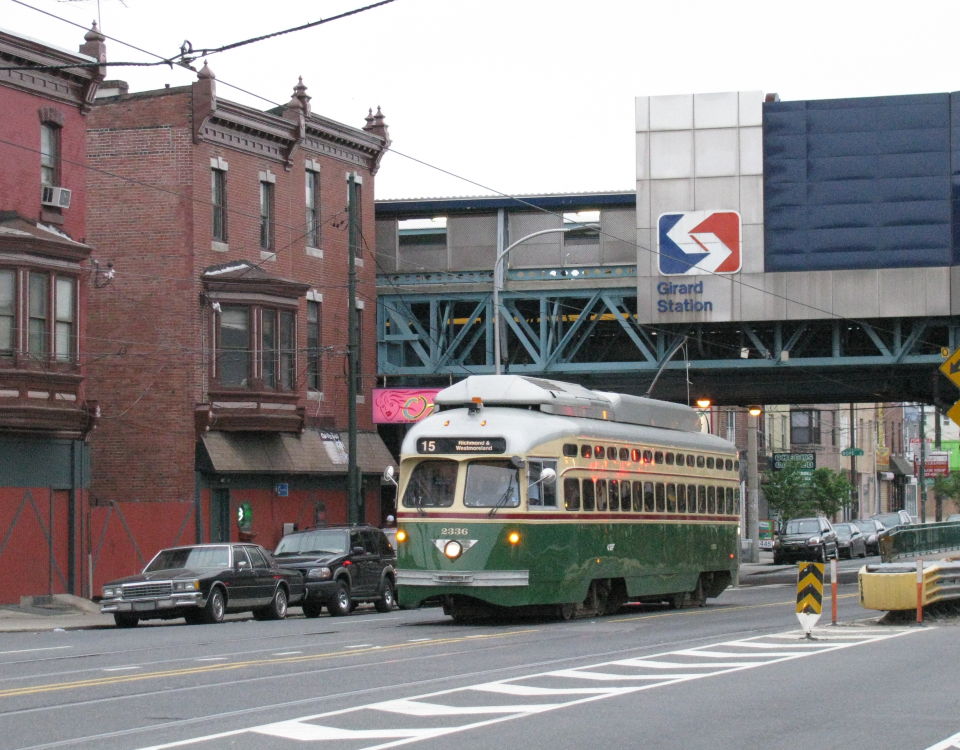 The PCC car is itself almost a living fossil. The type was introduced in the 1930s and built in large numbers for US systems. Philadelphia was among the last cities to use them in significant numbers – or indeed to use trolleys a all in a period when most other cities abandoned them. It is not surprising that many Philadelphia PCCs were sold to San Francisco as their celebrity became apparent. But these here are the real things in the city they were built for.
The PCC car is itself almost a living fossil. The type was introduced in the 1930s and built in large numbers for US systems. Philadelphia was among the last cities to use them in significant numbers – or indeed to use trolleys a all in a period when most other cities abandoned them. It is not surprising that many Philadelphia PCCs were sold to San Francisco as their celebrity became apparent. But these here are the real things in the city they were built for.
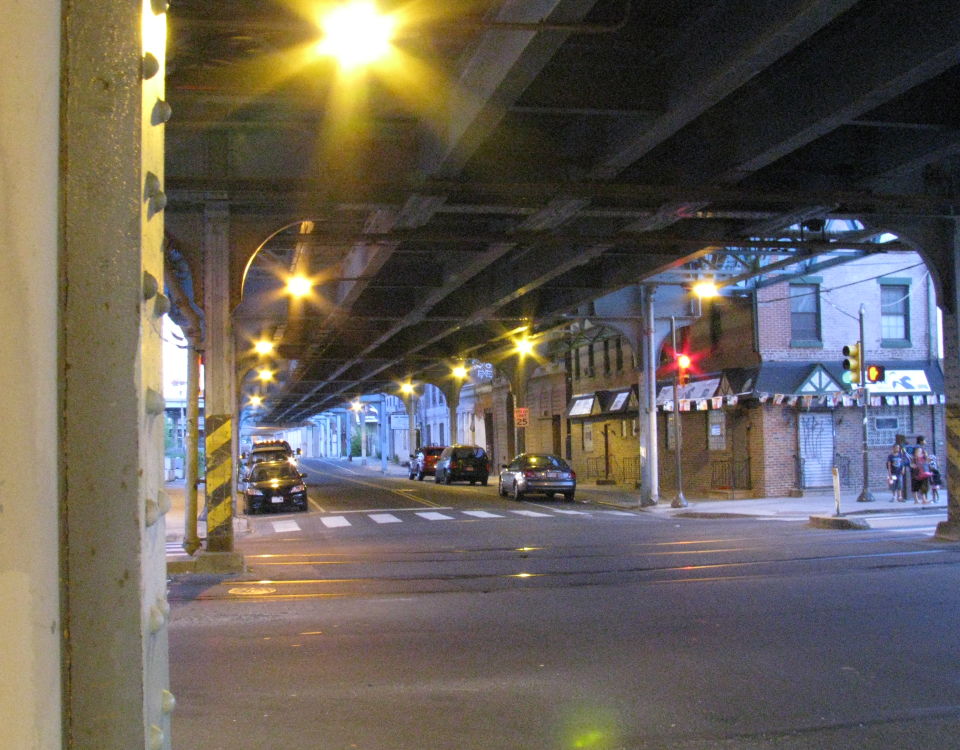 I rode the Market-Frankford line to Gerard Street station, where route 15 also runs. Following the subway section, the Market-Frankford line runs along the median of a highway before running as an elevated railway. This provides some views over the majestic Delaware river and its bridges.
I rode the Market-Frankford line to Gerard Street station, where route 15 also runs. Following the subway section, the Market-Frankford line runs along the median of a highway before running as an elevated railway. This provides some views over the majestic Delaware river and its bridges.
Down at street level, Gerard Street appears run down and desolate. Many of the once-beatiful Victorian houses are abandoned or cheaply repaired. With the onsetting dusk, I decided to explore the area in more detail by daylight and having bought something to eat from an all-night shop, with a surprisingly delicious selection of foods on display I rode back to the hotel.
Part 1 | Part 2 | photos
Zürich tram newslog